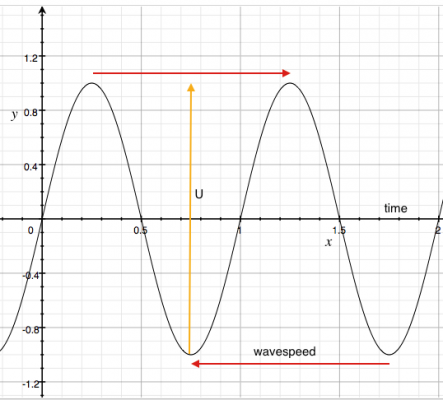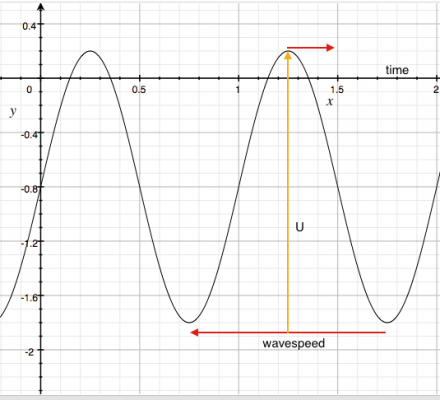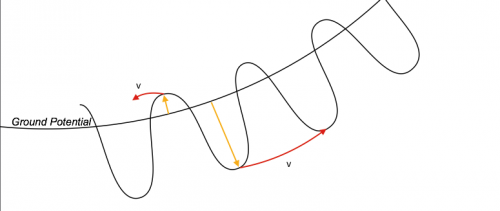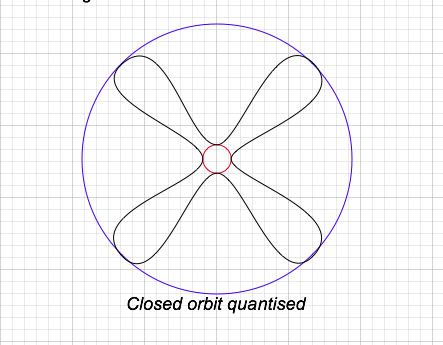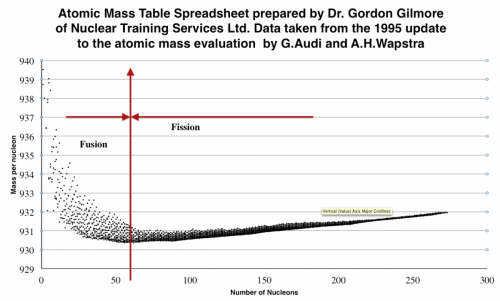-
Posts
145 -
Joined
-
Last visited
Content Type
Profiles
Forums
Events
Everything posted by beejewel
-
Hi guys, Three months pass quickly, still working at it I got stuck on a problem involving the electrons velocity. GP theory states that the electrons velocity ought to be, [latex] v_e = c (\frac{\Delta\phi}{\Phi})[/latex] This was the basic problem I attempted to solve. [latex]F = K\frac{qq}{r^2} = \frac{mv^2}{r} [/latex] That the electrical force between the electron and the proton in Hydrogen should equal the centripetal force. But when I applied this to the electron cloud of an H atom, the result was out by a factor of 1000, and it was driving me bonkers, after many sleepless nights I realised what the problem was. The electron in orbit around a proton is under constant acceleration, much the same as the accelleration felt by humans as they are bound to the surface of the earth. Acceleration has the effect of forcing a body to occupy a potential other than it's natural potential, and in the case of the H atom, it's surface potential can be calculated by knowing its overall mass and dividing by the number of nucleons, which in the case of H is one. Hydrogen has a mass of 939.2 MeV/c^2 so when we drop the c's and the e's we have a potential of 939.2 MV, so [latex]\Delta\phi[/latex] ie. (939.2 MV - groundpotential) = 8.8 MV, using the following constants of which the atomic radius appears to be the least well known; Proton Mass - 938.3 MeV Electron Mass - 0.5 MeV Hydrogen Mass - 939.2 MeV Ground Potential - 930.4 MeV Hydrogen Radius - 25 pico meter (empirically measured radius) The solution came out pretty close; [latex]F = K\frac{qq}{r^2} = 3.69 * 10^{-7}[/latex] and [latex]F=\frac{mv^2}{r}=2.98*10^{-7}[/latex] The small calculated difference between the electrical force and the centripetal force is most likely due to the Hydrogen radius which is not well defined. More work to do... Steven PS: Providing my assumptions above are correct, the exact radius for the Hydrogen atom calculated is 32.02 pico meters Wolfram Alpha: http://www.wolframalpha.com/input/?i=%28coulomb+constant+*+elementary+charge%5E2%29%2F%28electron+mass*%28c%288.8%2F938%29%29%5E2%29&a=*C.c-_*Unit- Lookup Atomic Radii: http://www.webelements.com/hydrogen/atom_sizes.html Further discussion: http://groundpotential.org/forum/viewtopic.php?f=5&t=33
-
Hi guys, swansont is right, you guys have pointed out weaknesses in my theory or maybe just pushed me into a corner where I have not yet developed sufficient skills, either way weather you realise it or not, you have all been helpful to me , so thanks to all. Give me some time to ponder on these problems, and I shall hopefully return with another piece of the puzzle soon.
-
Noop, you got that wrong, you (the observer) will measure the electron mass to be 0.5 Mev everywhere now, but over time your potential will inevitably fall, causing a rise in the electrons mass. Please take the time to understand this part, as it connects to free will. Deliberately changing your potential you are changing the electron to proton mass ratio everywhere, and in doing so you are changing your world. This view is very different from a fatalistic view where the world is a theatre stage on which you act out your life The current cosmological model and standard model of particle physics is backed up by too much paper, and that is a weakness because a small spark carefully directed, might bring it down I am a dreamer, and I want to believe that the world can be explained in simple terms that even a child can understand, my one year old son is not yet able to talk, but he has already figured out how gravity works and has taken his first steps. His brain has already performed the calculation which programmers at the Honda robotics tream are still trying to get right. Yes there is a lot of work to do, but maybe someone reading this will offer to collaborate on a paper, I think there is enough new material here to publish something of interest. Enlighten me please, what is the nature of charge and what causes a particle to be charged? Why is it that an electron has excactly the same charge potency as a massive proton 1836 times its size? What is tunneling, why can particles do this? Steven PS; I am saving my cosmological model for another thread, it isa so different to the big bang model, it deserves it's own thread.
-
If we interpret the equation correctly it says the mass of the electron is a function of the observers potential, my understanding of this is that the present value of the electrons mass is across all space. So an observer at ground potential, looking out into space, will observe all electrons as having the same mass. My statement above is therefore not well formed, as the electron mass and observer potential changes together (rather obvious when you look at the full equation). So why do we still see a redshift in the spectrum? The standard theory says this is because space is expanding. My view is is the inverse, I think ground potential is falling, this gradual decliine of ground potential, has the same effect as expanding space. My reason for preferring a falling ground potential is that matter which makes up the earth is in a state of continuous decay, and therefore in costant fall. This theory must agree with current observations of the Hubble redshift. The point I was trying to make here is that protons do not repel each other with some invisible force or spooky action at a distance, the nature of force is relative velocity in four-space, so when two particles such as protons have the same velocity and momentum in four-space, there are no forces to stop them drifting together, quite the opposite, as the electron part of the wave will provide a potential well for both particles to become trapped in, which is why di-hydrogen molecules form almost immediately. The nature of force is relative velocity, positive charges repell, because they have velocity relative to the observer, and act as a gas under pressure. Opposite charges converge for the same reason, as one particle moves backwards in time relative to the observer and the other particle moves forward in time. Despite the obvious difference in mass between the electron and the proton, we observe them as having equal but opposite charge, this is due to the proportionality between velocity and mass, causing both to have the same momentum. [latex] p=vm_e = vm_p [/latex] which is further evidence for this proportionality. [latex] \frac{v}{c}=\frac{\phi}{\Phi} [/latex] Steven
-
Continuing on the subject of Ground Potential theory, for more information, please refer to the earlier thread with the rather silly title "Spooky Idea late for Halloween" and "Humpty Dumpty", I also have a dedicated website for this theory at http://groundpotential.org Overview Ground Potential theory is based on the assumption that the electron and the proton are a particle pair, this conclusion has been derived from several clues that point to a highly offset observer potential, giving the observer a very one sided view of the world. I believe I have found the equation that correctly relates the mass of the electron to the mass of the proton, this equation in its simplest form is as follows: [latex] \phi_e = \frac{\Delta\phi\gamma}{2} [/latex] where [latex] \phi_e [/latex] and is the electron potential, and [latex] \Delta\phi [/latex] is the difference between the proton potential (mass) and ground potential (average mass per nucleon of earth). In this form the equation is not very useful, because [latex] \gamma [/latex] involves velocities, and clearly we have no apparent velocities to work with here. I consequently derived that there was a proportionality between velocity and mass as follows. [latex] \frac{v}{c}=\frac{\phi}{\Phi} [/latex] Where [latex] \phi [/latex] is ground potential and [latex] \Phi [/latex] is the proton potential (mass), this allowed me to write out the whole equation as follows; [latex] \phi_{e}=\frac{\Phi-\phi_{gnd}}{2}\sqrt{1-\frac{\phi_{gnd}^2}{\Phi^2}} [/latex] Where, by plugging in the numbers we arrive at a ground potential of 930 million volts. Solution here at Wolfram Alpha: http://www.wolframalpha.com/input/?i=0.511%3D%28%28938-x%29%2F2%29*√%281-%28x%5E2%2F938%5E2%29%29 It was no surprise to me that the answer came out so close to Ni-62, we already suspected that the Earth's core is most likely made of iron, and Ni-62 is the nucleus with the lowest mass per nucleon, towards which all other isotopes decay. I personally think this is very strong evidense for this solution. Objections For those of you who have not read the earlier threads, there were some objections to the theory, and I would expect nothing less. A few 24 carat bullets were fired by the golden gun, but none were fatal. There was a strong objection to my unconventional use of the term potential, but it came down to semantics, because the theory works just as well using the term mass. Definition My convention is to drop the c's and drop the e's (in electron volts) and use the term potential and the unit of Volts in my calculations. I refer to to these potential as phi_e for electron potential, just phi for ground potential and Phi for the proton potential. Gamma = Gamma Due to the proportionality between velocity and mass (shown above) we can show that the following is true. [latex] \gamma=\frac{1}{\sqrt{1-\frac{v^2}{c^2}}}=\frac{1}{\sqrt{1-\frac{\phi^2}{\Phi^2}}} [/latex] This allows us to solve the equation for velocity in four-space, with respect to mass, and reduces to; [latex] v=c(\frac{\phi}{\Phi}) [/latex] for relative velocity between the observer and a moving body the equation becomes; [latex] v_{rel}=c(\frac{\Delta\phi}{\Phi}) [/latex] We shall now see how we can solve the motion of the particles in an H atom. Speculations on Wave Speed This section is about the wave speed and how it may be affected by observers at high potential. To keep this simple enough for me to understand I am considering a simple wave function [latex] \psi(x,t) [/latex] In this above image, we can see a simple sine wave with peaks and troughs symmetric around the time axis, the wave potential U is the full potential of the wave from peak to trough. So what will be the wave speed of the peaks and the troughs? [latex] v_{crest}=c(\frac{U-0.5U}{U})= 0.5c [/latex] and [latex] v_{trough}=c(\frac{0.5U-U}{U})= -0.5c [/latex] So what this is suggesting is that the crest of the wave travels forward in time at 1/2 the speed of light and the trough travels backwards in time at half the speed of light. Well crazy as this looks, it's excactly what happens when a particle pair are created, and the reason our radio waves don't appear do this is because in our world U is the potential of the proton, which is 938 million volts, and the typical radio waves in the order of volts, so the difference between the trough and the peak is very small. Now let us look at the same wave, when observed by an observer at higher potential. Here we can see that the observer is offset to the positive 0.9U and let us calculate the wave speed of the peak and the trough. [latex] v_{crest}=c(\frac{U-0.9U}{U})= 0.1c [/latex] and [latex] v_{trough}=c(\frac{0.1U-U}{U})= -0.9c [/latex] This is a very strange wave indeed, it has a peak moving slowly forward in time, and a trough moving fast backwards, so it is obvious that this wave is curved, and spinning backwards. Depending on the amount of offset this curvature may be very clight or very significant, for most photons this curvature might not even be measurable, but for matter waves the curvature can be so tight, that vaves close back in on themselves and cause constructive and destructive interferance with themselves. I speculate that this interferance with itself may be the cause of quantised energy, and may be able to explain the electron shells in a new way. Here is a scetch of how such a closed wave might look in two dimensions. The mind only boggles when trying to think of these things in three, let alone four dimensions (a job for the dedicated mathematicians). I think it should be pretty obvious where I am heading with this post, based on the logic you have just read, I believe there is a strong case to suggest that Hydrogen is such a closed wave, with the electron being the trough and the proton being the peak. We know their mass very accurately and using my equation we can calculate their speed, using the numbers 938 MV for the proton, 930 MV for ground potential and 0.511 MV for the electron. What we see is a dumbell shaped wave with a slightly offset centre of rotation, the proton moving forwards at 2,500,000 m/s, and the electron moving backwards at 0.991c. The protons tight orbit and speed, which is on the order of the escape velocity from our Galaxy, is what I suspect is responsible for the coulomb force. From my calculations I see absolutely no need for any "force" in the Newtonian sense, the apparent repulsion between protons is nothing more than velocity, much in the same way molecules in a gas under pressure appear to repel each other, it's nothing more than movement. Likewise attraction between protons and electrons is negative movement if that makes sense. The perfect balance between the positive and negative charges is further evidense that mass and velocity are absolutely proportional. otherwise the two particles with such different mass could simply not have had the same charge. It is this simple proportionality which has unlocked the mystery for me, and hopefully for everyone else too. [latex] \frac{v}{c}=\frac{\phi}{\Phi} [/latex] It's a new way of looking at the physical world, from the top down, at 930 million volts, the view is pretty good Steven http://groundpotential.org
-
Ah, yes sorry to have confused you. Technically it would be possible to nucleo-synthesize Ni-62 in a matter of minutes, and bring the potential of a proton down by 8 MeV, but we are now sitting on a rock at that potential, and reasonable evidense says this took 13.8 billion years. The nuclear synthesis process are like the rungs on a ladder, or the cogs in a clock's governor, so quantised if you like. I know in D+D fusion the momentum is conserved between the neutron and the He^3 nucleus. There is another more gentle way potential can change, and that is acceleration. No one has asked this question yet, but I claim that ground potental is 930 MV, same as the Ni-62 nucleus, so the obvious question is, we are not made from nickel, so why are we at 930MeV? The potential of the atoms in our body are somewhere between Hydrogen and Carbon, so according to my equation we aught to be moving relative to the Earth, and when you do the calculation you see that the vector is towards the Earth, hence the constant acceleration. [latex] v_{rel}=c(\frac{\Delta\phi}{\Phi})[/latex] A negative velocity vector means a heavy body is approaching from the future, and a positive velocity vector means a lighter body is approaching from the past. The direction of the vector is always inwards directed towards the observer. Incidentally this is evidense that antigravity can never occur.
-
I re-read your post again, and think I understand what you mean, but still not sure if/how the electrons change in mass violates this. The mass changes are quantised events, say two nuclei fuse, causing a sudden drop in proton potential, gain in electron potential, coupled with the ejection of one or more particles. Is there any way that the change in momentum or ejection of a particle can prevent the violation? Note: Post by Syn5 makes no sense at all to me so I am ignoring it.
-
Would this still be the case if the electron-proton is the same wave function? The way I see it, these two particles are the peaks and troughs of the same wave, so when you integrate the wave function in four-space I agree the energy must be constant. Steven
-
I see, can you show me in more detail where/how this violation occurs ? Steven
-
I think we need to take a holistic view, and think of the electron and the proton as a pair, this way the overall energy is not lost. The proton starts its life as a single particle with a potential of 938 MeV, at this early stage it's antiparticle (the electron) has a zero mass, it then pairs up with another proton which happens to be travelling in the same 4-momentum space, and forms a diproton, (there are no coulomb forces in my theory so this is possible), the merger of two protons into a diproton followed by the first fusion process represents a drop in potential, which is accompanied by a gamma ray of 0.42 MeV, so the proton has now taken the first step down the ladder, and now has a potential of 938.27 MeV less 0.42 MeV = 937.85 MeV. At this stage the electron gets its mass. From the Deuterons point of view, the electrons mass would appear to be 0.0062827 MeV or 6.2 keV (Using my equation in Wolfram Alpha) So I think I should point out here that every electron in the universe would appear as having that mass if you were a deuteron, not just the electron associated with your mass, same as we see all electrons as having a mass of 511KeV, get it? The mass of an electron has nothing to do with the electron, it's a function of YOU! Philosophically we need to change the way we study the physical world. If your car keeps driving through red light cameras, attracting heavy fines (like mine), it is of little use looking under the hood for the problem Steven
-
I can't say for sure, but I have a gut feeling that the equation is describes matter reaching the SR radius, where it annihilates sending one photon into the future and one into the past. From our perspective we can't see this happening, but from far away it should look something like a quasar. The matter (baryons) do not disappear, they simply turns up again at the edge of the galaxy and start a new life spiralling inwards. As I said this is just my gut feeling and therefore speculative, but it might be worth investigating. Yes, I agree, radioactive decay should vary with time, and sorry if I missed some of your questions further up the thread, this thread is becoming a bit too long. The electron has gained 511 KeV since the beginning of time, say 13.8 billion years. So to answer your question... [latex]\frac{(electron-mass)}{(age-of-universe)}[/latex] That's a lot of decimal places... electron mass = 510.998910(13) keV - Say 8 significant figures change p/a ... = 000.0000000370 So it looks like we might be 100 years from measuring this, but if we assume our measuring technology improves it may only take half as long. I am very confident it will be found, and I hope I live long enough to see it. Steven
-

How to find whether a given number is prime or not?
beejewel replied to burgess's topic in Mathematics
Basically yes, the prime numbers are represented as spheres, with one sphere being the number 2, two spheres being the number 3, three spheres being the number 5 and so on, the shape that forms around the primes is the composite. Think of it like 12 eggs and an egg carton Large groups of spheres can represent complex shapes, think about it and you realise you are such a shape. In fact in my system you (we) are prime numbers. Keep in mind that the human mind is far better at recognising objects than numbers, my 1 year old boy can already recognise many complex objects. Intended more as an aid to teach children about primes, not for finding the prime factors in encryption algoritms. Sterven VisualNumbers.pdf -
As the observers potential falls, the rest mass of the electron increases, to the point when the electron mass is 469 MeV, at this point, the electron and the proton will annihilate and become two photons. This little gif animation is intended to explain how I see it working. Sorry, trying my best ... No There are a couple of predictions I can make, but all are just outside my capability of measuring. One prediction is that the electrons mass increases with time, this will no doubt be established in the next 10-50 years. Another prediction is that nuclear decay rates should change as a function of the observers potential. This prediction could be easier to manipulate, as some kind of measuring apparatus could be enclosed in a faraday cage and artificially charged to positive or negative potentials of at least + and - 100 kV that would be a change in potential of 0.2% or two parts in a thousand. But even though I manufacture gamma spectrometry systems, (gammaspectacular.com) and also happen to have a 100KV power supply from my old fusion experiments, the tolerance of 2 parts in 1000 is too tight for me to measure reliably. Steven
-

How to find whether a given number is prime or not?
beejewel replied to burgess's topic in Mathematics
Some time ago I devised a system of visual numbers, which makes it easy to see prime factors.. I did a page on fb here if you have a fb account you can check it here. https://www.facebook.com/worldofnumbers -
MigL You better hurry up and enjoy yourself, because the proton does not decay to zero volts. As the ground potential falls, the electrons potential rises, they will meet in the middle and annihilate. You only have half as much time as you thought..
-
Is it really that hard to follow this? Think of the energy in every proton-electron pair as a clock spring, when it is fully wound up, it has a tension of 938 MV i.e.. it has potential to do 938 MeV worth of work. It is possible for the spring to unwind, but only by falling to lower potentials, and it can only do this by converging with another proton forming a nucleus. The first such merger is the fusion of H to D, then D+D to He3, then B and so on, think of these fusion processes as the governor (anchor) on the clock spring, there are no possibilities inbetween these known reactions. This process continues down to iron and Ni-62 (that's ground potential - where you are) the process stops temporarily there, any mass at lower potential than ground potential will actually fall UP! It floats, yes buoyancy is what we call it. But as more and more of the Earths elements decay, U, Th, K etc. not to mention man's efforts to speed up this process, the core becomes heavier, and ground potential gradually falls away. I know excactly how far ground potential has fallen since the beginning of time, I can work it out by knowing the mass of the proton and that mass of the electron because the relationship is: [latex] \phi_e = \frac{\Phi-\phi_{gnd}}{2} \sqrt{1-\frac{\phi_{gnd}^2}{\Phi^2}}[/latex] All this says is that the mass of the electron is half the difference between the proton mass and the mass per nucleon at ground potential multiplied by [latex] \gamma [/latex] I could simply have written, [latex] \phi_e = \frac{\Delta\phi\gamma}{2}[/latex] So when you do the numbers, it turns out that ground potential is 930 million volts, and proton potential is 938 million volts, therefore ground potential has fallen 8 million volts since the beginning of time. Google puts the age of the universe at 13.8 Billion years, so lets divide 8 million by 13.8 billion and the drop in potential is 0.00057971014 Volts per year That's of course if google knows That's pretty clear...
-
Slowly converging here, however the proton is not the lowest energy state, it is the state of the observer, which if we assume we are on the same planet (sometimes I wonder) then it's ground potential. As I pointed out further up the thread, the lowest point is Ni-62 which currently lies at a potential of 930 MV towards which all elements decay towards if they can, but even ground potential is gradually falling by around 0.5 millivolts per year, so to MigL's reply above, even the proton will eventually decay. Just to clarify that last statement, it is the observer that decays the proton, and not the other way around, this is a tricky part to understand, more on that later. Steven
-
Remember for this to work we have made one assumption or postulate, that the electron and proton are a pair. From that flows that the potential difference between them can never exceed 938 MV, and that comes from simple reasoning that we drop the c's and drop the e's, so we are still talking about potential as a difference. So we should agree to continue debating the consequences on these terms, otherwise we are going around in circles. As is pretty obvious to all, I think the above is a reasonable assumption, and the fact that we have a universe full of electrons and protons, with every proton the same as every other proton, and every electron the same as every other electron, is good evidence, further we have not found a single stable particle with more mass than a proton. Just think about this for a moment...
-
Ajb, Bring me a stable fermion heavier than the proton, and I shall reconsider my case Steven
-
"observers rest mass plus momentum is mc^2" It's wrong, I make mistakes too
-
The ratios, [latex] \frac{v}{c}=\frac{\phi}{\Phi} [/latex] are proportional, because, [latex] \frac{v \Phi}{c \phi}=0 [/latex] Nothing can travel faster than light, and no potential can exceed the protons potential.
-
This should be the general four-space form of the proportional term; [latex] \frac{v}{c}=\frac{\phi}{\Phi} [/latex] If [latex] p=\gamma m_o v [/latex] and [latex] p=m_0 U [/latex] then we should be in agreement with relativity when I say that these terms are proportional. For the relative form it should become; [latex] \frac{\Delta v}{c}=\frac{\Delta \phi}{\Phi} [/latex] This thread is becoming long, I might start a new thread, on speculations about how I see this affecting the wave speed.
-
After distilling this right down over a good nights sleep, we are basically debating weather the following ratio is true. [latex]\frac{v}{c}=\frac{\phi}{\Phi}[/latex] Where v is the observers velocity and phi is the observers potential and Phi is the protons potential (you can call it mass per nucleon if you dont like the term potential) The part that says observers velocity v is proportional to phi should agree with relativity because observers rest mass plus momentum is mc^2 The denominator part is the only thing new suggested by me, that c is proportional to Phi. So the mass of a proton is proportional to c, well nothing new there either, it's only how we interpret it. Will ponder some more and start a new thread soon.. Steven
-
ajb, The chart of nucleides is usually presented with Ni-62 at the top, because it has the highest binding energy (whatever that is). I like to present it the right way around showing Ni-62 at the bottom where I believe it should be. I see both fusion and fission as decay processes. I actually spent quite a bit of time and money building ion sources and particle accellerators in my own workshop, successfully fusing deuterium and producing measurable amount of neutrons. I applied for no less than three fusion related patents, so these ideas were not developed in any orifice as some of the members arrogantly suggest. Regarding your question, I am 100% sure that no fission/fusion energy can be gained from nickel or iron itself, there may be a slight chance of slowing down a proton to the point where it fuses with Nickel to produce Ni-62 but in order to do that it needs to loose around 8 MeV of its kinetic energy, and I can't see any easy way to do this. PS: The protons velocity with respect to an observer at ground is worked out as follows. [latex]v_{p}=c(\frac{\Phi-\phi_{gnd}}{\Phi})[/latex] putting in the numbers... [latex]300,000,000 m/s ((938MV-930MV)/938 MV)=2,558,635 m/s[/latex] This means protons simply don't stand still, when observed from our potential, the only way to slow them down is to capture them in a heavier nucleus, but how do you capture a proton travelling at 2.5 million m/s, hence the impossibly small cross section in p+p fusion (only from our potential). In the early Universe when ground potential was a lot higher, the velocity of the proton would have been significantly less, so p+p fusion would have been common place in the early Universe. It's late here now, so I will no doubt read about how the Universe was much hotter in the past, but that's tomorrow
-
Moderator, It is far from my intention to argue with the members that the standard model is wrong. I am presenting a view, based on the principles of SR, which seems to suggest that the observers potential is limited. Solving my equation for the mass of the electron and the proton, gives a value for ground potential as follows. http://www.wolframalpha.com/input/?i=0.511%3D%28%28938-x%29%2F2%29*√%281-%28x%5E2%2F938%5E2%29%29 It certainly came as no suprise to me that the answer equated to the mass per nucleon of Ni-62 to within 70 KeV, the nucleon with the lowest mpn, it seems reasonable that Ni-62 can not yield any energy by fission or fusion, because it is already at ground potential. All the other elements have higher potentials in their nuclei, and therfore decay towards the lowest point. Further we concider living on a rock made from continuosly decaying isotopes of U, K, Th etc which are decaying below our feet emitting gamma rays, and it seems reasonable to assume that the potential is falling as time passes, ie, ground potential can not be constant. I can go on to show a few more examples, but as a one man show, I can't provide proof of every experiment ever done, all I can do is present the idea which I believe has merit, and see if there are any takers who agree with the view and want to collaborate and look deeper into it. Note, we don't choose our religion based on how many people believe in it, so why do it with science?


